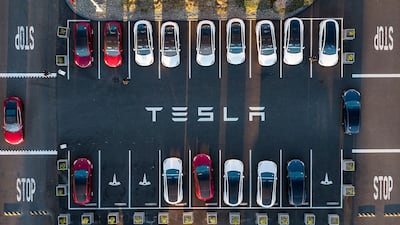Since the beginning of this year, US car buyers have been eligible for a federal tax credit of up to $4,000 for the purchase of a used electric vehicle, one element of the consumer incentive programme in the Inflation Reduction Act.
It is the first time that federal credits have been extended to used vehicles. Already, the incentive and its accompanying price cap are sending ripples through the market, according to data from Seattle-based start-up Recurrent, and helping to increase the availability of affordable EVs.
While the used-vehicle credit is not bound by the domestic sourcing requirements that apply for new EVs, it does come with conditions: buyers cannot make more than $75,000 annually or $150,000 a year in jointly filed taxes. The credit cannot be applied to the same vehicle twice. And the vehicle has to be at least two years old, sold by a dealer and cost no more than $25,000.
When the bill was first announced last summer, says Scott Case, co-founder and chief executive of Recurrent, it seemed as if the price cap would make it largely irrelevant.
Prices for used cars of all kinds had surged to historic highs during the pandemic and mostly stayed there. “You were just never going to find one under $25,000,” he says.
In August 2022, when the the act became law, only 12 per cent of used EVs on the market in the US would have qualified for the credit, according to the company’s data. Finding an eligible and available new EV was even harder.
But during the autumn, as interest rates continued to rise, used car prices for both combustion-engine and electric vehicles went into decline. By December, the share of used EVs at less than $25,000 had risen to more than 16 per cent. In January, spurred in part by the new credit taking effect, it jumped to 20 per cent.
“I think there's a powerful incentive for dealers to price just under that mark,” Mr Case says.
Founded in 2020 to help EV buyers, owners and sellers keep tabs on their vehicles’ battery health, Recurrent also tracks prices by scanning the listings from tens of thousands of US dealerships every day.
The company uses this data to compile a price index for a bundle of eight popular used EVs, including the 2019 Tesla Model 3 and 2017 Chevrolet Bolt.
From their peak last July through this January, the average price of the cars in the index fell from $42,265 to $32,677.
The new federal incentive has changed the way Platt Auto Group, a dealership outside of Portland, Oregon, that specialises in used EVs, does business.
“Just the other day, we had a Chevy Bolt that came in that should have been priced at $26,000 and we purposely priced it $24,900 just to attract that credit,” says Greg Platt, the dealer principal.
“Maybe it’s foolish to do that, but it sold within less than one day.”
Mr Platt says he has been increasingly hunting for cars that he can sell profitably either below the $25,000 threshold or well above it.
“We’ll avoid a car like that that's going to sell for 26, 27, or 28,” he says. “You might as well just go to something even newer that’s over 30 because it’s going to eliminate the tax credit anyway.”
For now, the IRA incentive may be having a bigger impact on US car dealers than consumers. Mr Platt says that while a few customers have come in specifically because of the credit, most are not aware of it until he tells them.
It serves, he says, as a deal sweetener: “It’s not people breaking down the doors to use it, but it's definitely helped.”
For buyers looking to take advantage of the credit, the models most likely to be eligible are Chevy Bolts made between 2017 and 2020 and some lower-range or older-model Nissan Leafs.
A Bolt for less $25,000 that still has at least 200 miles of range on its battery will “disappear instantly” from the lot, Mr Platt says.

Those looking for larger or more luxurious used EVs will probably have to keep waiting. Dink Davis, owner of iDrive1 Motors, a Dallas-area dealership that specialises in used Teslas as well as electric models from Porsche, Mercedes, Rivian and others, says he has yet to sell a car for $25,000 or less this year.
While the market for the types of vehicles he sells has come down significantly in recent months — “to the tune of over $20,000 per car” as Mr Davis puts it — it is still well above the federal threshold.
“It’s a great tax advantage for the customer, but it doesn’t affect how our profit margins work,” he says.
“And I’m not going to lose money so somebody else can get a tax break.”
Still, Mr Davis anticipates that as new EV models from Hyundai, Kia and others reach the used market, he will start stocking cars below $25,000.
“I think that’s coming maybe in the next two years,” he says.
“And we’ll be prepared. I’ll go buy as many of them as I can put in here.”


